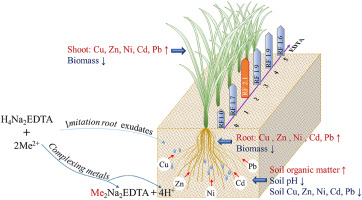当前位置:
X-MOL 学术
›
Ecotox. Environ. Saf.
›
论文详情
Our official English website, www.x-mol.net, welcomes your feedback! (Note: you will need to create a separate account there.)
EDTA-enhanced phytoremediation of heavy metals from sludge soil by Italian ryegrass (Lolium perenne L.).
Ecotoxicology and Environmental Safety ( IF 6.8 ) Pub Date : 2020-01-24 , DOI: 10.1016/j.ecoenv.2020.110185 Fei-Li Li 1 , Yuehua Qiu 1 , Xinyang Xu 1 , Feng Yang 1 , Zhiwei Wang 2 , Jianru Feng 1 , Jiade Wang 1
Ecotoxicology and Environmental Safety ( IF 6.8 ) Pub Date : 2020-01-24 , DOI: 10.1016/j.ecoenv.2020.110185 Fei-Li Li 1 , Yuehua Qiu 1 , Xinyang Xu 1 , Feng Yang 1 , Zhiwei Wang 2 , Jianru Feng 1 , Jiade Wang 1
Affiliation

|
Landscaping of sludge is a kind of recycling disposal, but the potential heavy metal risks limit its application. In this paper, the sludge soil was remediated by ryegrass, and the effect of ethylene diamine tetraacetic acid (EDTA) was studied through pot experiments. Italian ryegrass was planted in the sludge soil treated with six gradients concentrations of 0, 1, 2, 3, 4, 5 mmol kg-1 of EDTA, and the planting conditions were kept the same. After 45 days of planting, compared with the control group (without EDTA treated), the application of 1-5 mmol kg-1 EDTA decreased ryegrass biomass by 2-43%, reduced soil pH value by 0.21-0.34 unit, and reduced 4.1-9.7% capacity of exchange cation, but increased 1.4-8.6% soil organic matter. After growing ryegrass, the contents of heavy metals decreased by 10% for Cu, 15% for Zn, 6% for Ni, 14% for Cd and 44% for Pb; and after spraying EDTA decreased again by 33% for Cu, 31% for Zn, 56% for Ni, 24% for Cd, and 68% for Pb. In ryegrass, the uptake heavy metals were enhanced, and bio-concentration factor of Cu, Zn, Ni, Cd, and Pb of EDTA treated groups were 1.9, 1.6, 4.1, 2.7, and 4.8 times of the control group, respectively. However, EDTA only significantly increased transfer factor values of Cu and Zn, and made bio-extraction factor value of Cu greater than 1. The remediation factor values were used to comprehensive assess accumulation capacity of heavy metals by ryegrass under EDTA treating, and they ordered in Zn > Cu > Ni > Cd > Pb, and the best dose was 2 mmol kg-1 EDTA. Prediction models for bio-concentration factor were established by using stepwise multiple linear regression, explaining 94.9-99.3% of the corresponding elements with soil organic matter, EDTA dosage, and/or pH value (p < 0.005). This paper provided effective heavy metals remediation data for municipal sludge landscape and the prediction models.
中文翻译:

EDTA增强了意大利黑麦草(Lolium perenne L.)对污泥土壤中重金属的植物修复作用。
污泥的景观化是一种回收处理,但潜在的重金属风险限制了其应用。本文用黑麦草修复了污泥土壤,并通过盆栽试验研究了乙二胺四乙酸(EDTA)的作用。将意大利黑麦草种植在以0、1、2、3、4、5 mmol kg-1 EDTA的6种梯度浓度处理的污泥土壤中,并保持种植条件不变。播种45天后,与对照组(未经EDTA处理)相比,施用1-5 mmol kg-1 EDTA减少了黑麦草生物量2-43%,土壤pH值降低了0.21-0.34单位,降低了4.1交换阳离子的容量为-9.7%,但增加了1.4-8.6%的土壤有机质。黑麦草生长后,重金属的含量分别为:铜10%,锌15%,镍6%,镉为14%,铅为44%;喷涂后,EDTA再次下降:铜33%,锌31%,镍56%,镉24%,铅68%。在黑麦草中,重金属的吸收增加,EDTA处理组的Cu,Zn,Ni,Cd和Pb的生物富集系数分别是对照组的1.9倍,1.6倍,4.1倍,2.7倍和4.8倍。然而,EDTA仅显着增加了Cu和Zn的转移因子值,并使Cu的生物提取因子值大于1。补救因子值用于在EDTA处理下综合评估黑麦草对重金属的累积能力,并命令锌>铜>镍>镉>铅时,最佳剂量为2 mmol kg-1 EDTA。通过使用逐步多元线性回归建立生物浓度因子的预测模型,解释了94.9-99。3%的相应元素具有土壤有机质,EDTA剂量和/或pH值(p <0.005)。本文为城市污泥景观提供了有效的重金属修复数据和预测模型。
更新日期:2020-01-26
中文翻译:

EDTA增强了意大利黑麦草(Lolium perenne L.)对污泥土壤中重金属的植物修复作用。
污泥的景观化是一种回收处理,但潜在的重金属风险限制了其应用。本文用黑麦草修复了污泥土壤,并通过盆栽试验研究了乙二胺四乙酸(EDTA)的作用。将意大利黑麦草种植在以0、1、2、3、4、5 mmol kg-1 EDTA的6种梯度浓度处理的污泥土壤中,并保持种植条件不变。播种45天后,与对照组(未经EDTA处理)相比,施用1-5 mmol kg-1 EDTA减少了黑麦草生物量2-43%,土壤pH值降低了0.21-0.34单位,降低了4.1交换阳离子的容量为-9.7%,但增加了1.4-8.6%的土壤有机质。黑麦草生长后,重金属的含量分别为:铜10%,锌15%,镍6%,镉为14%,铅为44%;喷涂后,EDTA再次下降:铜33%,锌31%,镍56%,镉24%,铅68%。在黑麦草中,重金属的吸收增加,EDTA处理组的Cu,Zn,Ni,Cd和Pb的生物富集系数分别是对照组的1.9倍,1.6倍,4.1倍,2.7倍和4.8倍。然而,EDTA仅显着增加了Cu和Zn的转移因子值,并使Cu的生物提取因子值大于1。补救因子值用于在EDTA处理下综合评估黑麦草对重金属的累积能力,并命令锌>铜>镍>镉>铅时,最佳剂量为2 mmol kg-1 EDTA。通过使用逐步多元线性回归建立生物浓度因子的预测模型,解释了94.9-99。3%的相应元素具有土壤有机质,EDTA剂量和/或pH值(p <0.005)。本文为城市污泥景观提供了有效的重金属修复数据和预测模型。



























 京公网安备 11010802027423号
京公网安备 11010802027423号